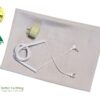Earthing and the Gut Brain Axis
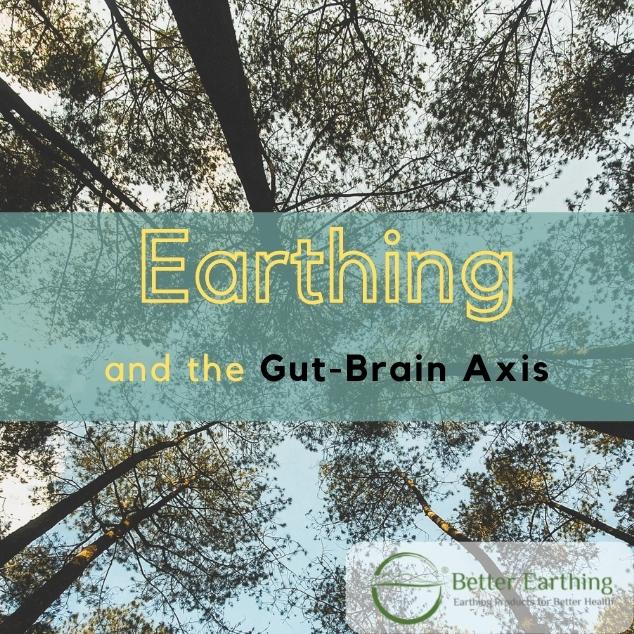
Have you ever had butterflies in your stomach before speaking in public? Or lost your appetite after hearing some bad news?
These sensations tell us something we’ve long intuited – our brain and our gut are connected.
The two-way communication from the brain to the gut microbiota, and from the gut microbiota to the brain, has become a hot topic in the world of medicine and natural health. Studies on the gut-brain connection have led to new insights for Alzheimer’s Disease, Parkinson’s Disease, Autism, anxiety-depressive behaviours and mental health. Changing your intestinal microbiota can improve your mood, energy, or even your capacity to learn.
How can we influence our gut microbiota?
The health of your gut microbiome is influenced by many factors from diet to physical activity, age, pathogenic bacteria, stress, and more. A less-known influencer is earthing.
Earthing is the act of grounding your body to the earth and receiving free electrons. It is a surprisingly effective way to positively influence the vagus nerve, reduce stress, and improve blood flow, which in turn supports a healthy gut.
Gut Brain Axis Explained
Trillions of bacteria, fungi and other gut microbes combine to form your gut microbiome in your gastrointestinal tract from lips to anus. These are known as your microbiota. The bidirectional relationship between microbiota-gut-brain is not yet fully understood.
But we do know that your gut microbiota operates independently of your brain.
It can be considered a “second brain” with its nervous system called the enteric nervous system (ENS).
Your second brain or “gut-brain” is a neurological, endocrine, and immune organ. It regulates pain perception, and influences learning capacity, memory, mood, and emotion.
The “gut-brain” may have as much influence on your personality and how you feel as your regular brain!
Gut Brain Axis and Stress
Many stressors can affect the gut microbiota in the GI tract. These include pathogens, toxins, antibiotics, and mental or emotional stress; all of which have the potential to damage the thin gut lining and disrupt the delicate balance of the gut bacteria.
When an imbalance of the gut microbiome occurs, it creates gut dysbiosis or a disturbance in the microbiota composition and density of gut microbiota.
Even short-term exposure to stress can change the proportions of different types of gut microbiota. Having less diversity of the microbiota with an uneven distribution of bacteria types can create food cravings, impact your metabolism, make you more reactive to stress, and even compromise your immune system.
You may have heard of “leaky gut syndrome” where, as a result of gut permeability, bacteria behind the intestinal barrier seep into circulation. A 2013 study found this was especially the case with people with already high levels of cortisol, the stress hormone. Unhealthy food choices, especially comfort eating, help cement the path from stress to gut dysbiosis and can alter metabolic changes. One study found that healthy women who experienced daily stressors had higher insulin, lower resting energy expenditure, and lower fat oxidation after eating a fast-food meal compared to women who were not stressed.
Natural Healing of the Gut Microbiome
Healing of the microbiome can be simple for some and incredibly complex for others. This is because our microbiome is influenced not just by our adult habits, but also by early childhood, including as far back as being a foetus in our mother’s womb. Yes, the diversity of your mother’s microbiome, and the type of birth you had, can impact your adult gut health.
Dietary changes can be effective in rebalancing the microbiome. Approaches can include:
- Identifying and removing food triggers.
- Introducing a wide variety of nutrient-dense foods to feed the many different forms of bacteria that make up a healthy, happy microbiome.
- Using prebiotics and probiotics to repopulate the gut and improve bacterial balance. New research on probiotics and the roles of specific strains of bacteria continues to reveal that we can target a particular concern with the right strain for better results.
- Introducing a fibre-rich diet will help to feed the good bacteria so they can proliferate in the gut. Fibre is processed by your enteric microbiota to create various neurotransmitters and boost feel-good factors.
For complex and chronic problems, a new and still debated approach that has emerged is Faecal Microbiota Transplantation (FMT). This is based on the premise that healthy human gut flora can be transplanted from a donor to the recipient via an enema or endoscopy containing healthy human faeces. Studies show promise for debilitating conditions like Clostridium Difficile.
What is Grounding
Earthing or grounding is the act of bringing free electrons from the earth into your body, whether by walking barefoot on grass or using an indoor earthing product.
The earth’s surface has a subtle negative charge created from atmospheric pressure and near-continuous lightning strikes around the globe. It is a storehouse of electrons, the tiniest unit of negative charge. Find out more in What is Earthing.
There have been over twenty published research studies on earthing or grounding and its effects on the body from sleep to cortisol levels, to blood circulation and the vagus nerve. While the direct influence of earthing on gut microbiota has not yet been scientifically studied, we believe that earthing has an indirect influence on digestion and gut inflammation due to the way it affects vagal tone and moderates stress.
Earthing, Vagal Tone and Stress Reduction
The vagus nerve is one of the main components of the parasympathetic nervous system which helps us feel calm and digest our food, among other functions. 80-90% of fibres of the vagus nerve transmit information from the gut to the brain. One of the ways gut bacteria can positively influence mood and reduce anxiety is by improving vagal tone, or the function of the vagus nerve. This is typically measured via the high-frequency component of heart rate variability(HRV).
A 2017 study on the impact of earthing on preterm infants measured the heart rate variability of 20 infants before, during and after earthing. As premature babies, these infants were vulnerable to stress and were at risk of developing enterocolitis which can be fatal. The researchers found the vagal tone increased by 67% with earthing, and concluded that earthing may improve resilience to stress.
These findings echo an earlier 2011 study(1) on 28 healthy adults. The participants were asked to sit for two hours in a comfortable chair with earthing patches on their palms and soles of their feet.
The researchers used a switch to connect the patches to the earth 40 minutes into the session and turned the earthing off after 40 minutes, making for a 40-minute earthing session in total.
Participants were not told when earthing would start or stop.
Below is a graph of the high-frequency component of HRV parameters, which doubled in the grounded group as compared to the sham grounding group over the 40 minutes of earthing. This shows that grounding helps activate the parasympathetic nervous system. These results go beyond that of relaxation, which can be viewed in the grounded group whose high-frequency HRV stayed steady.
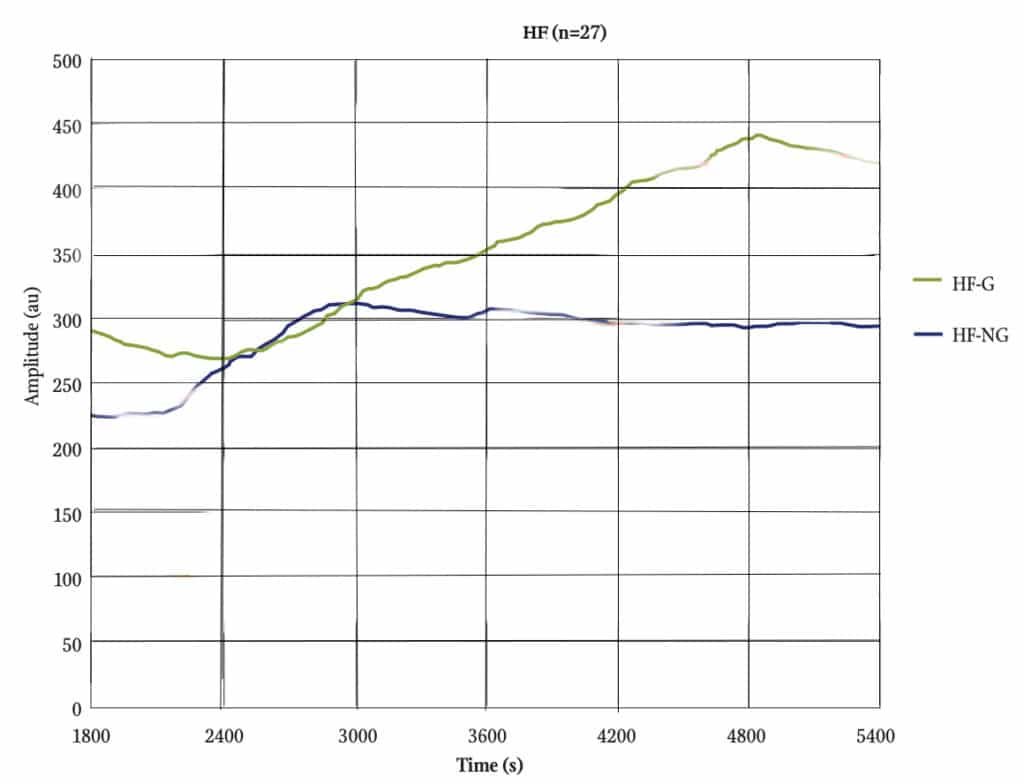
Given the upward trend of HRV continued right to the end of the grounding session, the researchers argued that greater benefits may be experienced with more time grounded.
Grounding has the potential to support HRV, reduce excessive sympathetic overdrive, balance the Autonomic Nervous System, and thus, attenuate the stress response.
Earthing and Cortisol
Cortisol is a hormone produced in higher amounts when we are under stress. It also helps regulate our sleep cycle. Our body has a clock sometimes called a circadian cycle that is responsible for helping us feel sleepy at night and alert in the morning. Cortisol participates in this process by spiking in the morning, to help us feel alert, and dropping at night. A 2005 pilot study on earthing measured the effect of earthing overnight on a grounding mattress pad in 12 participants over 8 weeks. Cortisol secretion tests were done at the start and 6-weeks into the test period. There was a measurable reduction of cortisol during night-time sleep, and a resynchronisation of peak cortisol to the morning (on waking) and lower cortisol at midnight.
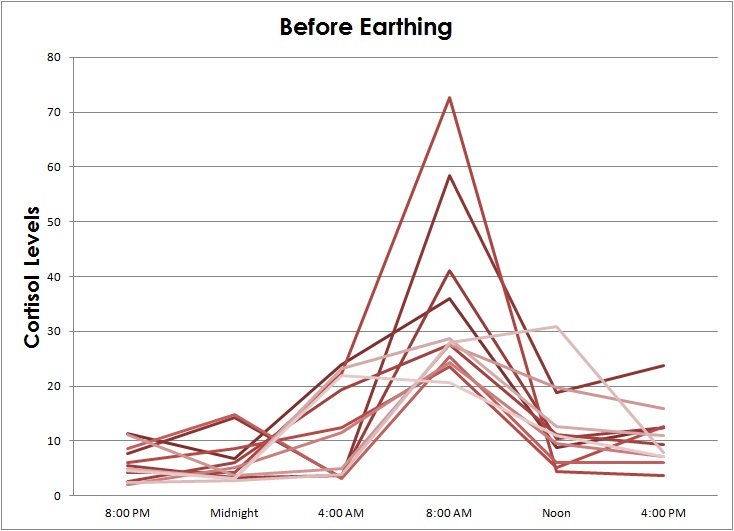
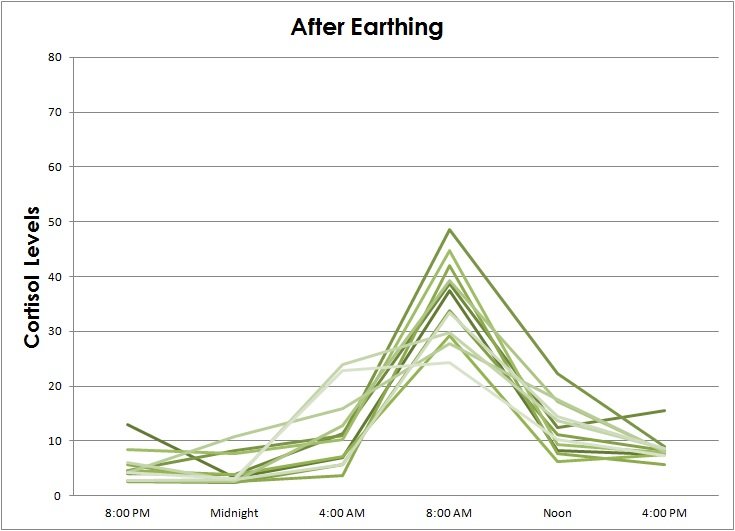
Furthermore, the participants reported less pain overnight, less interruption of sleep, and more energy during the 8 weeks.
New research suggests that our body’s circadian clock works in synergy with our microbial clock. So our gut microbiota affects our sleep cycle and vice versa. If you’ve ever experienced disturbed sleep when taking antibiotics, disturbed gut microbiota could be the reason why.
Sleep loss can impact metabolism, trigger changes in gut bacteria, and reduce the number of organisms, typically of the Lactobacillaceae family. It can also increase populations of Bacteroides multiforme, Enterococci, the Lachnospiraceae, and the Ruminococcaceae, which causes microbial dysbiosis, according to a review study on the role of microbiome in insomnia.
Because earthing can help improve sleep and reduce stress, it may well assist in balancing the gut-microbiota.
How to Get Started with Grounding
Starting your regular practice of grounding could be as simple as going to the backyard or local park and walking barefoot for some time. You may feel calmer and/or a warming or tingling feeling in your feet as you start to top up on electrons and energise your body. These are good signs that earthing is rebalancing your body’s systems.
If getting outside barefoot isn’t possible, or your body needs a bigger reset, a convenient way to earth is indoors either on an earthing underlay while you sleep, or sit on a grounding mat you work at the computer. Sleeping while grounded has the added benefit of helping normalise your overnight cortisol levels, which in turn, may support your microbiome.
(1) Chevalier G, Sinatra S., “Emotional stress, heart rate variability, grounding, and improved autonomic tone: clinical applications” Integrative Medicine: A Clinician’s Journal, 2011;10 (3).




